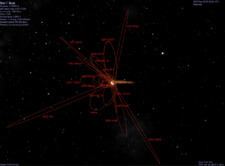Discovered by Mt. Lemmon Survey Observation arc 687 days (1.88 yr) Discovered 20 January 2013 Asteroid group Centaur Discoverer Mount Lemmon Survey | Discovery date January 20, 2013 Aphelion 2254 ± 8 AU
~ 1920 AU Absolute magnitude 10.8 Apparent magnitude 22.1 | |
 | ||
Minor planet category Trans-Neptunian object
Centaur (DES)
Damocloid Perihelion 8.365 AU (1.2514 Tm) (q) Similar 2012 DR30, 2007 TG422, 2008 ST291, 2003 QX113 | ||
2013 BL76 is a minor planet (centaur) from the scattered disk/Inner Oort cloud. Using an epoch of February 2017, it is the minor planet with the 5th largest heliocentric semi-major axis in the Solar system (larger ones include 2014 FE72, 2012 DR30, and 2005 VX3). 2013 BL76 has a barycentric semi-major axis of ~964 AU, which is the third largest barycentric semi-major axis of any minor planet.
With an absolute magnitude (H) of 10.8 and an unknown albedo, the object has an estimated diameter of 15–40 km. Since it has not been seen out-gassing, it is not known if it is a comet or not. It might also be a damocloid, a type of minor planet that was originally a comet but lost most of its near-surface volatile materials after numerous orbits around the Sun. It also might be a dormant comet that simply has not been seen outgassing.
2013 BL76 came to perihelion 8.3AU from the Sun on October 27, 2012, when it reached an apparent magnitude of about 20. In 1927, when it was 100AU from the Sun, it had an apparent magnitude of about 30.8. For comparison dwarf planet 90377 Sedna had an apparent magnitude of 21.7 when it was 100AU from the Sun. It comes to opposition at the start of September.
It will not be 50 AU from the Sun until 2045. After leaving the planetary region of the Solar System, 2013 BL76 will have a barycentric aphelion of 1920 AU with an orbital period of 29900 years.
The orbit of 2013 BL76 currently comes closer to Saturn than any of the other giant planets. In a 10 million year integration of the orbit, the nominal (best-fit) orbit acquires a perihelion point of 0.5AU (inside the orbit of Venus), and one of the 3-sigma clones acquires a perihelion point of only 0.008 AU (1,200,000 km; 740,000 mi).
2013 BL76 travels in a technically retrograde orbit around the Sun. It is actually orbiting in a plane nearly perpendicular to that of the ecliptic. It has the 55th highest inclination of any known asteroid, after 2010 GW147 and before 2014 HS150.
